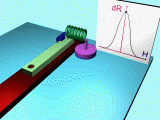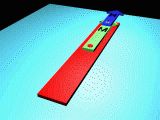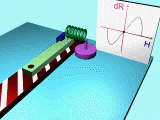The AMR Effect
The anisotropic
magnetoresistive effect (AMR) is known since the last century. It was detected
by Thomson in 1854?.
Many detailed description about AMR are found in the literature.
A recent study about limits of MR sensor sensitivity was performed by Bettner.
The aim of this web site is to provide a model to the user of MR technology and help him to understand MR sensor characteristics.
The AMR resistance
change is physically based on the angle variation between magnetisation direction
and flowing current direction. The MR user has to consider
1. how the magnetisation direction in thin magnetic films is influenced by
auxiliary magnetic fields ?
2. how the magneto resistance change depends on the angle between magnetisation
and current ?
A simple equation answers the second question:
R = R0 + dR * cos(2*a)
With R0 - average resistance without magnetic field, dR maximum resistance change.
The magnetisation
angle can be calculated by the stoner wohlfahrt equation, examples are given
in the literature.
A simple mechanical model, which is equivalent to the magnetic behaviour of
the thin film magnetisation, is shown in the following video.

Description of the model
| red | magneto-resistive stripe |
| green | magnetisation (able to rotate) |
| blue | the auxiliary magnetic field |
| green | anisotropy of the stripe |
The back side of the
video pictures shows characteristic MR curves and their operating points
at different magnetisation angles. Only magnetic fields perpendicular to
the stripe direction are used. These are weaker than the intrinsic anisotropic
field (weak field modus).
You can download a simulation tool of the stripe magnetisation here.
Magnetisation changes in stronger magnetic fields (strong field modus) are shown in the next video.

A linearization of the MR characteristic is reached with barber pole structures. This will be demonstrated by the following video. The effect of the barber poles is to rotate the current direction in 45°. literatur)

These were the basic elements that build the fundamentals of AMR-sensor characteristic.